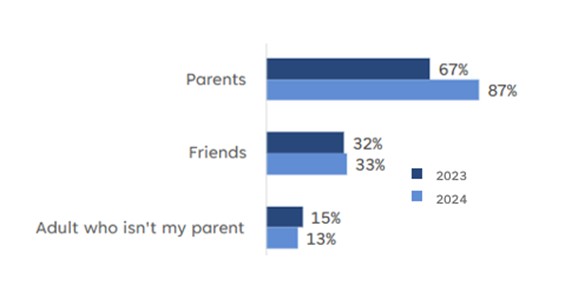By Courtney Gregoire, Chief Safety Officer
With growing interest in emerging technologies, including generative AI, Safer Internet Day provides an opportunity for people of all ages to engage and discuss online activities and safety.
February 6, 2024, marks Safer Internet Day – an annual event that brings people around the world together to create a safer and better online environment for all, especially for youth. Microsoft has a longstanding commitment to child online safety and, as we’ve recently outlined, we see a need for continuing research to help us all keep evolving our approaches. So, as part of our ongoing participation in Safer Internet Day, we’re releasing the latest findings from our annual Global Online Safety Survey, along with two new resources to help parents engage with their children: a Family Safety Toolkit and a new educational game from Minecraft.
Microsoft’s annual survey, in its eighth year, seeks to better understand people’s online experiences to inform our approach to digital safety. We share our results publicly so that others can benefit from the insights as we collectively strive to create a safer digital ecosystem. With the launch of generative AI tools, this year’s survey included a particular focus on how people of all ages perceive the opportunities and risks posed by this emerging technology. Our survey shows:
Millennials and Generation Z are driving the uptake of generative AI, with higher familiarity and early adoption leading to greater excitement
Young adults are the most active users and experimenters (56%). The use of AI as a practical tool excited respondents the most, including for translation purposes (43%), work (32%), and school (31%).
Active users and experimenters of generative AI by age group
However, 87% of respondents were worried about at least one potential risk arising from generative AI, including concerns around its use for scams (71%) and deepfakes (69%). These worries steadily increased with age – Generation Z was least concerned while Boomers were most concerned.
Encouragingly, our survey found that 87% of youth are talking to their parents about online risks. However, greater awareness of safety features and tools is needed
Compared to our 2023 research, the results show a 20-point jump in the number of teens who talked to their parents about online risk. In fact, young people are more likely to speak to their parents than their peers and friends.
Who teens talked to about online risks
While more teens are talking to their parents, our research results suggest a decline in the use of safety features. For example, the use of private accounts, the most popular safety feature in last year’s research, fell from 64% in 2023 to 56% in 2024. Parental control use remained steady – 90% of parents reported using at least one parental control, with female caregivers the most active in engaging with their children’s online activities.
Download the full Canada-specific infographic to learn more about our survey findings here.
New online safety resources for youth, parents, and educators
Enabling users and their families to support informed choices about their online activity is even more important with the advent of generative AI. Importantly, our survey results show that young people trust their parents and go to them for support and guidance around online risk. To help young people, educators, and families navigate the digital world, we’re releasing two new online safety resources. We also recently published a toolkit for students and educators to help them in their use of generative AI in learning environments.
- Microsoft Family Safety Toolkit. We realize parents and caregivers are busy, and that the tech landscape keeps evolving. This new toolkit provides guidance on how to leverage Microsoft’s safety features and family safety settings to support and enhance digital parenting, plus guidance for families looking to navigate the world of generative AI together. We’ve also included links to a selection of informational resources already made for parents, such as the Family Online Safety Institute’s How To Be A Good Digital Parent Toolkit.
- “Good Game” from Minecraft Education. “Good Game” is the newest addition in in the CyberSafe collection of immersive Minecraft worlds designed to help young people stay safe, happy and thriving online. This adventure teaches players the responsibilities, tools, responses, and strategies that enable healthy online interactions, collaboration, and rewarding digital experiences, whether those are part of multiplayer gaming or other online activities. The CyberSafe collections are among the most downloaded educational content on the Minecraft Marketplace, having been downloaded more than 25 million times by players worldwide.
- The Classroom Toolkit: Unlocking generative AI safely and responsibly. Now available for educators, the Classroom Toolkit blends narrative stories with instructional information to create an immersive and effective learning experience for students aged 13-15 years. The toolkit is designed to help initiate conversations about responsible AI practices in the classroom, such as the critical topics of content fabrications, privacy considerations, bias awareness, and mental wellbeing.
Microsoft remains committed to creating safer online environments for all
We recognize the role we play as a tech company in protecting individuals, particularly youth, from harmful and illegal online content and conduct. Safety by design is at the core of our products, and we remain committed to continuing to support and work closely with partners across industry, government, and civil society to create a safer online world for all.
Additional resources Microsoft provides to strengthen online safety:
- Resources | Microsoft Online Safety
- Xbox Family Settings app
- The Xbox Gaming Safety Toolkit
- Microsoft Family Safety
Report Methodology
Microsoft has published annual data since 2016 that surveys how people of varying ages use and view online technology. This latest consumer-based report is based on a survey of nearly 17,000 individuals that was conducted this past summer in 17 countries* examining people’s attitudes and perceptions about online safety tools and interactions. Responses to online safety differ depending on the country. Full results can be accessed here.






